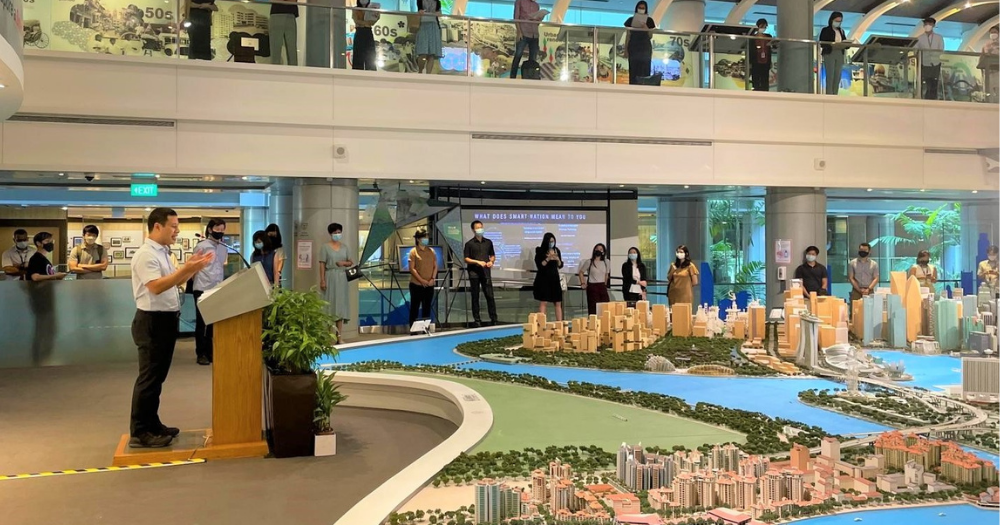Follow us on Telegram for the latest updates: https://t.me/mothershipsg
On July 17, Minister for National Development Desmond Lee launched the public engagement exercise for Singapore’s Long-Term Plan Review (LTPR).
Together with the Second Minister for National Development, Indranee Rajah, Lee had a closed-door discussion with 20 youth.
The LTPR is the Urban Redevelopment Authority's (URA) latest review of Singapore's long-term land uses and strategies.
In his opening speech, Lee said that the long-term plans for Singapore are reviewed “based on changing trends and needs, to ensure that we can continue to provide sustainable and high-quality living environment for everyone.”
The review is carried out every 10 years.
With Singapore’s land scarcity and position as a city state, Lee emphasised the need for careful planning.
Today, Singapore is already "highly built-up" and has "significantly less land to work with", he added.
Talking about the public engagement for the review, Lee said, "We welcome a diversity of views and want to hear from Singaporeans from all walks of life."
Singapore's long-term planning approach
URA's long-term plans charts Singapore’s land use for the next 50 years and beyond.
Previous Concept Plans have "made strong imprints on the urban structure around us today", shared Lee.
The Marina Bay area was envisioned in the 1971 Concept Plan, the first version of Singapore's long term plans, which laid the foundations of the city today.
Lee quoted how the 1971 Concept Plan also “seeded the idea of our MRT network” and relocated our civilian airport from Paya Lebar to Changi, a move that "created room to grow Changi as a global aviation hub".
Lee said that while many people were skeptical about whether these ideas were practical or necessary back then, these ideas bore fruits and we have benefited from them.
A focus on resilience, flexibility and inclusiveness
Lee shared that Singapore is "facing more uncertainties", citing the existential threat of climate change, economic and technological disruptions, and the Covid-19 pandemic.
In response, the revised long-term plan "will focus on flexibility, resilience, and inclusiveness", said Chief Planner Hwang Yu-Ning.
Some considerations include enhancing food resilience, caring for the needs of the elderly and young families, as well as buffering Singapore from the impact of climate change.
The pandemic has been a learning point for things we cannot fully anticipate in the future and emphasised the importance of resilience, Hwang shared.
For example, 2020 saw the repurposing of the EXPO Convention Centre to a community care facility, highlighting the need for land use to be flexible.
Another example of flexible land use is the Marina Barrage that doubles up as a recreational space while preventing flooding in low-lying city areas as a tidal barrier.
A multitude of plans
"Going forward, we are looking at a wider range of possibilities and flexibilities to be built into the plan" which "will cater to the changing circumstances and needs," Hwang shared.
While past Concept Plans have been distilled into a single prescribed plan, for this review, "the intent is to build optionality within the plan".
To do this, instead of one fixed plan, a multitude of plans will be drawn up to cater to a wide range of possibilities in meeting future needs to “accommodate different scenarios”.
The plan will also not be static, but rather regularly revisited and fine tuned.
Wider public engagement in reviewing long-term plans
URA aims "to put Singaporeans at the centre of the LTPR", Hwang said.
In engaging the public, URA can work "to ensure that the long-term plans reflect Singaporeans' hopes and aspirations, and address their concerns for their future".
The exercise will be carried out in four phases and taking place over the course of a year.
It will end in June 2022, when the plans will be presented to the public.
In previous public engagements, focus group discussions and exhibitions have been URA's primary methods for outreach.
This time, URA aims to use more online platforms to reach out to a wider audience to consult as many Singaporeans as possible.
In subsequent phases, different segments of the population can expect to be consulted through facilitated discussions and various platforms such as Townhall meetings.
Online poll opens till Aug. 16
In the first phase, online polls and workshops will be conducted to garner a wide range of views from the community.
This initial stage aims to identify the focus of the long-term plan, which will shape the subsequent discussions with deeper engagement.
One such online poll, consisting of eight multiple choice questions, is open from July 17 until August 16.
In one question, URA hopes to understand the public‘s opinion on how land use should change as working from home becomes more of a norm.
Guided by the long-term plans, the Master Plan, reviewed every five years, is likely to be released in 2024.
More information about the LTPR can be found on the URA website, and details about its next phases will be revealed in the future.
Top image via URA
If you like what you read, follow us on Facebook, Instagram, Twitter and Telegram to get the latest updates.

